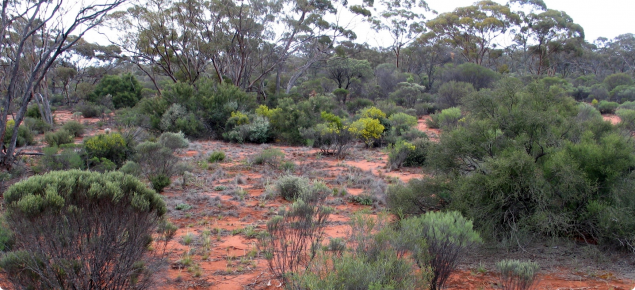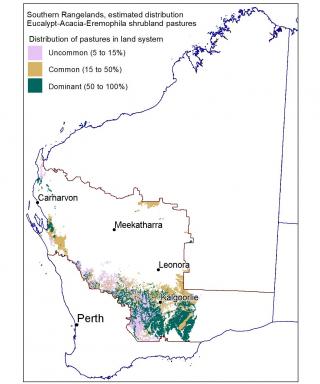Pastoral value – very low
Eucalypt-acacia-eremophila shrubland plain pastures have very low pastoral value.
Suggested levels of use (per annum)
Table 1 provides a rough guide to the range of pastoral values for good condition pastures, which must be checked against conditions in each region and paddock. Carrying capacities for fair condition pastures might be 75% to 50% of good, and poor condition pastures less than 50% of good.
See Introduction to pastures in the southern rangelands of Western Australia for an explanation of how carrying capacities are estimated.
| Condition | Carrying capacity ha/DSE1 | Carrying capacity ha/CU2 (ha/AE3) |
|---|---|---|
| Good | >30 | >210 (≥252) |
1 DSE is based on the feed energy required to maintain a 45 kilogram liveweight Merino wether with zero weight change, no wool growth additional to that included in maintenance, and walking 7 km/day. 1 DSE has an energy requirement of approximately 8.7 MJ ME/day.
2 CU in the southern rangelands is based on a 400 kg steer at maintenance and equivalent to 7 DSE.
3 AE is based on the feed energy to maintain a 450 kg Bos taurus steer 2.25 years of age, walking 7 kilometers each day. 1 AE has an energy requirement of approximately 73 MJ ME/day and equivalent to 8.4 DSE.
Management
They are generally not impacted by grazing as there are usually few palatable species present. Palatable species associated with tree-based clumps may disappear under heavy grazing. Some similar pastures that once supported chenopod understoreys in the southern Goldfields have transitioned into this form of eucalypt woodland pasture due to overgrazing, leading to a proliferation of unpalatable broom bush. It is likely that disturbances such as historic grazing, woodcutting, hail storms and/or fires are responsible for disappearance of the saltbush seed source. This transition is likely to be a permanent state.
Pasture condition
Survey data show that these pastures in the southern rangelands are predominantly in fair condition.
Good
See Figure 1. The most reliable indication of grazing impact is the diversity and density of palatable low shrubs (including saltbushes, bluebushes, cotton bush). Tree-based clumps are important indicators of condition. There is good mix of shrubs among tree-based clumps, including palatable bird-dispersed berry-bearing plants such as ruby saltbush, tall saltbush, lake-fringe rhagodia and currant bush.
Fair
See Figure 2. A reduction in palatable low shrubs may be evident, with or without an increase in unpalatable species such as broom bush or cassias. Tree-based clumps are not well-developed and palatable bird-dispersed berry-bearing plants are sparse or absent.
Poor
See Figure 3. Palatable low shrubs are absent. Unpalatable species may dominate the mid to low shrub strata (for example, broom bush, grey cassia, tomato bush). Tree-based clumps are absent. Soil erosion is usually associated with a decline in condition.
Eucalypt-acacia-eremophila shrubland plain pastures condition photographs
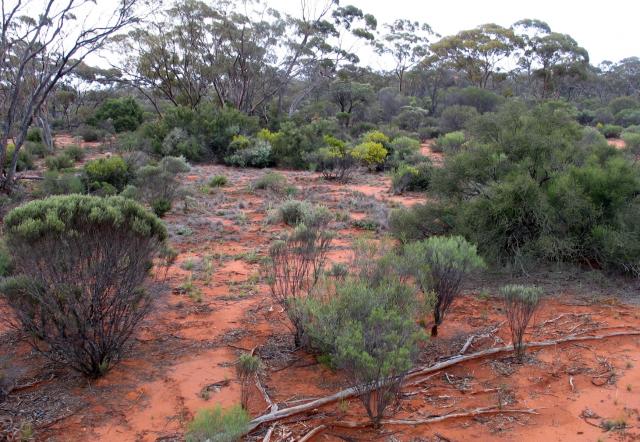
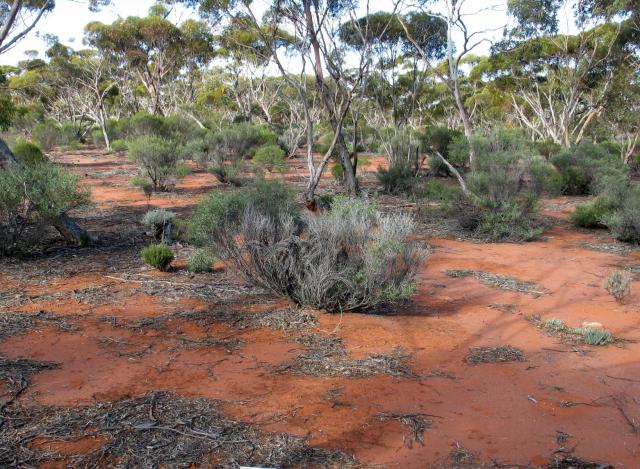
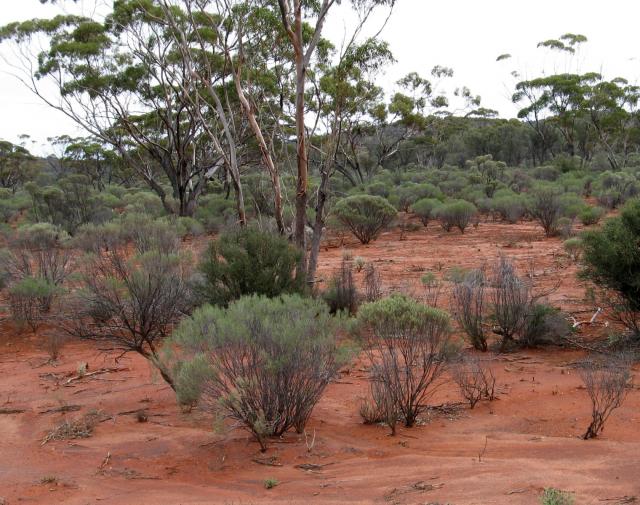
Vegetation structure and composition
Pastures range from scattered to moderately close low woodland, tall shrubland or eucalypt woodland, with projected foliar cover (PFC) ranging from 15–30%. Low shrub stratum is also well-developed, with a variably developed mid shrub stratum.
The variability in eucalypt species is influenced by regional distribution, geology or topographic location. The upper strata are often co-dominated by mallee eucalypts and tall shrubs (e.g. mulga). The combined tree-shrub layer is typically moderately close (20–25% PFC). In the southern Goldfields, tall trees (>15m) dominate the overstorey, and cover ranges from very scattered to moderately close (5–30% PFC).
The mid and low shrub stratum (2.5–15% PFC) is commonly dominated by acacias, cassias or eremophilas with few halophytic species. Halophytes may be present but these pastures do not support complex chenopod communities. Tree-based clumps are important microhabitats that indicate condition. These are characterised by suites of palatable low and mid-shrubs different to the acacias and other shrubs that predominate between tree-based clumps. Palatable shrubs may include saltbushes, ruby saltbush, bluebushes, cotton bush, tall saltbush and currant bush.
Perennial grasses are largely absent, but may include broad leaf wanderrie grass, greybeard grass or speargrasses when present.
Occurrence
These pastures are found on broad, level valley floors forming drainage tracts between extensive sandplains, very gently undulating to level plains draining into adjacent salt lakes and wide drainage tracts connected with large granite outcrops. They cover an estimated 4.53 million hectares (5.6% of the southern rangelands). They commonly lack a surface mantle, except where they grade into upland landforms. A variable mantle may be present. Soils are calcareous loamy earths, red loamy earths or red sandy earths, sometimes over hardpan or calcrete and generally receiving dispersed run-on.
Associated plants
| Common name | Scientific name (links to FloraBase) | Desirability* |
|---|---|---|
| Bladder saltbush | D | |
| Bluebushes | Maireana spp. | D |
| Broad leaf wanderrie grass | D | |
| Cane speargrass | D | |
| Cotton bush | D | |
| Currant bush | D | |
| Feather speargrass | D | |
| Golden bluebush, George's bluebush | D | |
| Grey copperburr | D | |
| Lake-fringe rhagodia | D | |
| Lax bluebush | D | |
| Ruby saltbush | D | |
| Tall saltbush | D | |
| Tar bush, fuchsia bush | D | |
| Warty-leaf eremophila | D | |
| Violet-flowered eremophila | U | |
| Broom bush | U | |
| Desert cassia | U | |
| Grey cassia, desert cassia | U | |
| Kidney saltbush | U | |
| Slender fuchsia bush | U | |
| Tan wattle | U | |
| Tomato bush | U | |
| Bowgada, wanyu, horse mulga | I | |
| Curara | I | |
| False bluebush | I | |
| Fine leaf jam | I | |
| Flannel bush | I | |
| Greybeard grass | I | |
| Mulga | I | |
| Speargrass | I | |
| Umbrella wattle | I | |
| No data | N | |
| No data | N | |
| Gums and mallees | Eucalyptus spp.1 | N |
| Hedgehog acacia | N | |
| Weeooka | N |
1 Prominent eucalypts include the Victoria Desert mallee (E. concinna), Goldfields blackbutt (E. lesouefii), smooth-barked York gum (E. loxophleba subsp. lissophloia), giant mallee (E. oleosa), salmon gum (E. salmonophloia), gimlet (E. salubris), redwood (E. transcontinentalis) and yorrell (E. yilgarnensis).
* D = desirable, U = undesirable, I = intermediate, N = no indicator value

